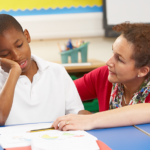School climate refers to the quality and character of school life, including aspects of engagement (e.g., strong and caring relationships among students, staff, and families; academic interest; social involvement), safety (e.g., emotional and physical security), and environment (e.g., well-managed facilities and learning environments).
Supporting LGBTQIA+ Students and Staff: The Power of Pronouns
Although pronouns, grammatically, may be small words that make it easier to refer to ourselves and others, they can carry large significance and meaning.
Continue reading →Supporting LGBTQIA+ Students and Staff: Glossary of Terms
In celebration of LGBTQIA+ History Month (October) and the contributions and achievements of the LGBTQIA+ community, we encourage school communities to create and maintain a culture of safety of expression for all students.
Continue reading →Handle With Care: Expanding and evaluating trauma supports for students
Now more than ever, many children and youth are exposed to potentially traumatic events, whether it be from community or school violence, natural disasters, or the sudden loss of a loved one.
Continue reading →Which Kindergarteners are at Risk of Being Bullied and/or Becoming Bullies, and What Can Educators and Parents Do About It?
Bullying occurs when children experience unwanted and aggressive behavior from more powerful peers repeatedly over time.
Continue reading →Promises and Pitfalls of PBIS Part 3: Strategies for educators to reduce implicit bias when responding to challenging behaviors
We highlight strategies educators can use to reduce implicit bias when responding to challenging behaviors, which is one of the five key components to reduce disproportionality in school discipline when implementing a PBIS approach.
Continue reading →Partner Blog Post: College and Career Pathways Measuring School Climate
The well-established connection between positive school climate and student success means that educators need to know how the climate at their school is faring. This information is particularly important now, after the prolonged disruptions in schooling from the COVID-19 pandemic. Getting and using feedback from students themselves about their school ...
Continue reading →Promises and Pitfalls of PBIS Part 2: Engaging Students and Families in Equity-Focused PBIS
In this second post in this series, we will discuss how to elevate the voices of students and families – one aspect of implementing a positive behavior framework that is preventive, multi-tiered, and culturally responsive.
Continue reading →Promises and pitfalls of PBIS Part 1: Importance of an equity-centered approach
Students who are Black, Latinx, and Native American are more likely than White students to be suspended or expelled – even when comparing consequences for the same infractions.
Continue reading →How can we keep students safe at school?
Acts of violence at school place pressure on educators and school leaders to better ensure the safety of their students. A comprehensive approach addresses school climate, student mental health programs, strategies to prevent violence, and physical security mechanisms. Our research has identified several promising practices to help keep students emotionally ...
Continue reading →Our evaluations of a program that addresses school climate and safety
Students learn best when a school establishes clear and consistent school-wide expectations for behavior. Establishing school-wide rules and routines can help prevent challenging behavior or negative incidents from occurring in the first place. Foundations is one example of a program that addresses school climate and safety by promoting positive discipline ...
Continue reading →









